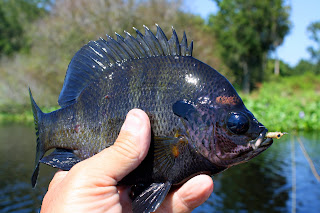 T
The Mighty Myakka Minnow was born out of frustration. I’m sure you’ve been there.
Imagine a day on the water with fish busting minnows throughout the morning. But after several hours, you still have nothing to show for your efforts. You cast into the spray of minnows, but your offerings are ignored repeatedly. The fish are so keyed into the tiny minnows that they ignore everything else.
Although the scenery is nice and weather gorgeous, it sure would be nice to feel the tug of a largemouth bass or hand-sized bluegill.
This happened to me several times while fly fishing on the Myakka River near my home in Sarasota, Fla.
After one unproductive outing, I decided to try and come up with a fly which would imitate the minnows the fish were so excited about.
I knew that the fly had to be no more than an inch long. It had to look like a minnow. It had to sink. It had to have large eyes.
After a few hours of trial and tribulation, I came up with a workable prototype and couldn’t wait to give it a try.
Next time out to the river, I had several Myakka Minnows in my box and one tied on my 4-weight fly rod. It didn’t take long to realize that I’d hit a home run. I picked up bass, bluegill, stumpknocker and tilapia while blind-casting. I kept my eyes open for scattering minnows. When I saw fish attacking minnows, I’d cast the Myakka Minnow into the fray.
Success is so sweet!
Over the years, the fly has worked very well and achieved a national reputation of sorts. It’s a pattern the Flymasters of Indianapolis featured in their Intermediate Fly Tying Class last spring. I’ve had email inquiries about the fly from interested anglers all over the country. I’ve even sold hundreds of them.
The fly isn’t a magic fly. But it does work very well when small minnows are the main food source. Then, it seems to be magic.
In fresh water, the fly has produced bass, bluegill, shellcracker, stumpknocker, redbreast sunfish, speckled perch and tilapia. Capt. Rick Grassett of Sarasota caught a nice brown trout on the Myakka Minnow in Montana. I have caught barramundi on it. You can tie it on larger hooks and go after saltwater fish. It has resulted in spotted seatrout, snook, redfish, mangrove snapper, jack crevalle, ladyfish, Spanish mackerel, tarpon and little tunny.
Capt. John Hand of Ruskin took a couple of No. 1 Myakka Minnows with him on a trip to Nicaraugua. He was targeting guapote (rainbow bass) and mojarra. He caught both.
“The Myakka Minnow was the only fly they’d hit,” said Hand. “And my guide said he’d never seen either species caught on fly.”
Stephen Piper of San Diego, Calif., emailed me and told me a similar story:
"We were fishing Diamond Valley Lake in SoCal and stripers and largemouth were busting threadfin shad. They were so focused on the shad that they would not take our flies.
"Sounded very much like the situation you described with fish and minnows -- were you fishing largemouth?
"Most of the morning, we had to let the flies drop way down in the water column below the boils -- to 20 feet or
so -- to catch a few.
"However, during some long lulls, I tried the Myakka Minnow -- shad variation - white marabou
tail, pearl diamond braid body with felt tip cool gray back, and UV knot sense to seal the
body, no weight. It seemed like everytime I cast it, it turned up a fish - all very small - including 8-10-inch largemouth
and a plump bluegill.
"We went back to fishing big flies deep, but at the very end of our
session, I tried the Myakka again to see if it really was "magic?"
"Yep, nailed another small bass to end the day.
"We were laughin' . . .
"Got a Myakka for the big models? That was amazing."
I sure do. The beauty of the fly is that you can tie it on any size hook to meet your needs. You can tie it small. You can tie it large.
About three years ago, Capt. Grassett had some large tarpon located around the Ringling Bridge on Sarasota Bay. They were feeding on glass minnows.
"But they won't hit any fly I throw," Grassett said.
That night, I tied up some "tarpon version" Myakka Minnows on 3/0 hooks and gave them to Grassett the next day.
A few days late, I got a call.
"Finally figured those tarpon out and jumped three," said Grassett. "All they'd hit was your Myakka Minnow."
I’ve discovered exotic species in the Florida Everglades absolutely love the Myakka Minnow. Used to be that I’d catch oscar and Mayan cichlids on poppers. But when the topwater bite ended, that was the signal to go home. However, I’ve learned it’s really the signal to tie on a Myakka Minnow. The fly has taken thousands of exotics over the years.
It’s a fun fly to fish and an easy fly to tie.
I’m sure there are similar flies out there somewhere, but the pattern was born in my head. I’ve never seen a fly like it in any shop or catalog.
Tie and few and see what you think.
What works best for me is to cast it out, let is sink for a couple of counts, then work it in erratically. I like a couple of 2-inch strips and a pause. But you’ll figure out what works best for you.




























